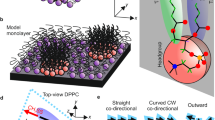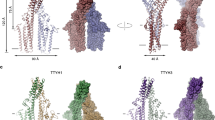Abstract
WE report here detection of two kinds of asymmetry in planar lipid bilayers which may bear on the problem of asymmetry in biological membranes. One kind of asymmetry arises as a consequence of an asymmetric distribution in the bilayer of lipids with charged polar head groups, and the other from an asymmetric distribution of lipids with different but neutral polar head groups. Several studies indicate that the lipids of the red cell membrane are asymmetrically distributed. In the erythrocyte membrane the outer half of the bilayer consists predominantly of neutral lipids, whereas the inner half contains all the negatively charged phospholipid phosphatidylserine1–3. In nerve axons such lipid asymmetry has not been demonstrated directly but can be inferred from surface charge measurements. These measurements indicate that at least in the neighbourhood of the sodium channel, the negative charge density is greater in the outer monolayer of the membrane4,5.
This is a preview of subscription content, access via your institution
Access options
Subscribe to this journal
Receive 51 print issues and online access
$199.00 per year
only $3.90 per issue
Buy this article
- Purchase on Springer Link
- Instant access to full article PDF
Prices may be subject to local taxes which are calculated during checkout
Similar content being viewed by others
References
Zwaal, R.F.A., Roelofsen, B. and Colley, C. M. Biochim. biophys, Acta., 300, 15–182 (1973).
Gordesky, S. E., Marinetti, G. V., and Love, R., J. Membr. Biol., 20, 111–132 (1975).
Fisher, K. A. Proc. natn. Acad. Sci. U.S.A., 73, 173–177 (1976).
Chandler, W. K., Hodgkin, A. L. and Meves, H. J. Physiol., Lond., 180, 821–836 (1965).
Hille, B., Woodhull, A. M. and Shapiro, B. I., Proc. Trans. R. Soc. Lond., B270, 301–318 (1975).
Rothman, J. E. and Dawdidowicz, E. A. Biochemistry, 14, 2809–2816 (1975).
Hall, J. E. and Latorre, R. Biophys. J., 15, 99–103 (1976).
Pornansky, M. and Lange, Y. Nature, 259, 420–421 (1976).
Szabo, G. Nature, 252, 47–49 (1974).
Haydon, D. A. Ann. N. Y. Acad. Sci., 264, 2–16 (1975).
Montal, M. Biochim. biophys. Acta., 298, 750–754 (1973).
Eisenberg, M., Hall, J. E. and Mead, C. A. J. Membr. Biol, 14, 143–176 (1973).
Hall, J. E., Mead, C. A. and Szabo, G. J. Membr. Biol., 11, 75–97 (1973).
Szabo, G. and Eisenman, G. Biophys. Soc. Abstr., 13, 175a (1973).
Hlaky, S. B. and Haydon, D. A. Biochim. biophys. Acta., 318, 464–468 (1973).
Sherwood, D. and Montal, M. Biophys. J., 15, 417–439 (1975).
Author information
Authors and Affiliations
Rights and permissions
About this article
Cite this article
LATORRE, R., HALL, J. Dipole potential measurements in asymmetric membranes. Nature 264, 361–363 (1976). https://doi.org/10.1038/264361a0
Received:
Accepted:
Issue Date:
DOI: https://doi.org/10.1038/264361a0
This article is cited by
-
Photodimerization induced hierarchical and asymmetric iontronic micropatterns
Nature Communications (2022)
-
Bilayer of polyelectrolyte films for spontaneous power generation in air up to an integrated 1,000 V output
Nature Nanotechnology (2021)
-
Asymmetry of the gramicidin channel in bilayers of asymmetric lipid composition: I. Single channel conductance
The Journal of Membrane Biology (1979)
-
Asymmetry of the gramicidin channel in bilayers of asymmetric lipid composition: II. Voltage dependence of dimerization
The Journal of Membrane Biology (1979)
-
Capacitance and conductance as tools for the measurement of asymmetric surface potentials and energy barriers of lipid bilayer membranes
The Journal of Membrane Biology (1979)
Comments
By submitting a comment you agree to abide by our Terms and Community Guidelines. If you find something abusive or that does not comply with our terms or guidelines please flag it as inappropriate.



